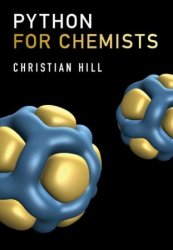 Название: Python for Chemists
Название: Python for ChemistsАвтор: Christian Hill
Издательство: Cambridge University Press
Год: 2024
Страниц: 559
Язык: английский
Формат: pdf
Размер: 10.2 MB
This accessible and self-contained guide provides a comprehensive introduction to the popular programming language Python, with a focus on applications in chemistry and chemical physics. Ideally suited to students and researchers of chemistry learning to employ Python for problem-solving in their research, this fast-paced primer first builds a solid foundation in the programming language before progressing to advanced concepts and applications in chemistry. The required syntax and data structures are established, and then applied to solve problems computationally. Popular numerical packages are described in detail, including NumPy, SciPy, Matplotlib, SymPy, and Pandas. End of chapter problems are included throughout, with worked solutions available within the book. Additional resources, datasets, and Jupyter Notebooks are provided on a companion website, allowing readers to reinforce their understanding and gain confidence applying their knowledge through a hands-on approach.
This book aims to provide a resource for students, teachers and researchers in chemistry who want to use Python in their work. Over the last 10 years, the Python programming language has been widely adopted by scientists, who appreciate its expressive syntax, gentle learning curve and numerous packages and libraries which facilitate numerical work.
The book is composed of relatively short chapters, each with a specific job. Mostly, these jobs fall into one of two categories: to act as a tutorial on a specific part of the Python language or one of its libraries, or to demonstrate the application of Python to a particular concept in chemistry. For students and teachers, these example applications are chosen to go beyond what can be reasonably achieved with a pencil, paper and a calculator: A brief overview of the chemical concepts is usually given, but there is no in-depth tutorial on these topics. Rather, it is assumed that the reader has some familiarity with the topic and wishes to use Python to solve larger or more complex problems than those usually presented in textbooks. For example, the chapter on Huckel molecular orbital theory (Chapter 33) outlines the assumptions behind this approach to modeling the electronic structure of organic molecules and then demonstrates the use of Python in determining the π molecular orbitals of benzene, which (using an unsymmetrized basis) involves a 6 × 6 matrix determinant: not a problem to be solved by hand.
Researchers are also increasingly using Python in their work as a computational tool, to manage and transform data, to produce publication-quality figures and visualizations, and even (using the JupyterLab package) as a replacement for laboratory notebooks, and to disseminate data and reproducible analysis. Indeed, Jupyter Notebook was listed in an article in the journal Nature as one of the ten computer codes that have transformed science.
Скачать Python for Chemists